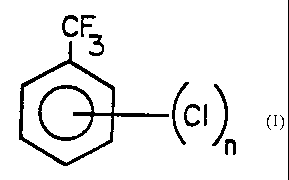Une partie des informations de ce site Web a été fournie par des sources externes. Le gouvernement du Canada n'assume aucune responsabilité concernant la précision, l'actualité ou la fiabilité des informations fournies par les sources externes. Les utilisateurs qui désirent employer cette information devraient consulter directement la source des informations. Le contenu fourni par les sources externes n'est pas assujetti aux exigences sur les langues officielles, la protection des renseignements personnels et l'accessibilité.
L'apparition de différences dans le texte et l'image des Revendications et de l'Abrégé dépend du moment auquel le document est publié. Les textes des Revendications et de l'Abrégé sont affichés :
| (12) Brevet: | (11) CA 2151139 |
|---|---|
| (54) Titre français: | METHODE POUR SEPARER LE CHLORE D'UN MELANGE DE GAZ |
| (54) Titre anglais: | METHOD FOR SEPARATING CHLORINE FROM A MIXTURE OF GASES |
| Statut: | Périmé et au-delà du délai pour l’annulation |
| (51) Classification internationale des brevets (CIB): |
|
|---|---|
| (72) Inventeurs : |
|
| (73) Titulaires : |
|
| (71) Demandeurs : |
|
| (74) Agent: | NORTON ROSE FULBRIGHT CANADA LLP/S.E.N.C.R.L., S.R.L. |
| (74) Co-agent: | |
| (45) Délivré: | 2004-06-29 |
| (86) Date de dépôt PCT: | 1994-02-14 |
| (87) Mise à la disponibilité du public: | 1995-01-05 |
| Requête d'examen: | 2001-02-08 |
| Licence disponible: | S.O. |
| Cédé au domaine public: | S.O. |
| (25) Langue des documents déposés: | Anglais |
| Traité de coopération en matière de brevets (PCT): | Oui |
|---|---|
| (86) Numéro de la demande PCT: | PCT/US1994/001927 |
| (87) Numéro de publication internationale PCT: | US1994001927 |
| (85) Entrée nationale: | 1995-06-06 |
| (30) Données de priorité de la demande: | ||||||
|---|---|---|---|---|---|---|
|
L'invention concerne un procédé pour extraire le chlore d'un mélange de gaz. Le mélange de gaz est mis en contact avec un liquide contenant un composé ayant la formule générale (I) dans laquelle n est compris entre 1 et 3. Dans ce procédé, le chlore du mélange de gaz est absorbé par le liquide. Le liquide est ensuite chauffé pour volatiliser le chlore et le séparer du liquide.
Disclosed is a method of removing chlorine from a mixture of gases.
The mixture of gases is contacted with a liquid which contains a compound
having general formula (I) where n is 1 to 3, whereby chlorine in the mixture
of gases is absorbed by the liquid. The liquid is then heated to volatilize
the
chlorine and separate it from the liquid.
Note : Les revendications sont présentées dans la langue officielle dans laquelle elles ont été soumises.
Note : Les descriptions sont présentées dans la langue officielle dans laquelle elles ont été soumises.

2024-08-01 : Dans le cadre de la transition vers les Brevets de nouvelle génération (BNG), la base de données sur les brevets canadiens (BDBC) contient désormais un Historique d'événement plus détaillé, qui reproduit le Journal des événements de notre nouvelle solution interne.
Veuillez noter que les événements débutant par « Inactive : » se réfèrent à des événements qui ne sont plus utilisés dans notre nouvelle solution interne.
Pour une meilleure compréhension de l'état de la demande ou brevet qui figure sur cette page, la rubrique Mise en garde , et les descriptions de Brevet , Historique d'événement , Taxes périodiques et Historique des paiements devraient être consultées.
| Description | Date |
|---|---|
| Le délai pour l'annulation est expiré | 2014-02-14 |
| Lettre envoyée | 2013-02-14 |
| Accordé par délivrance | 2004-06-29 |
| Inactive : Page couverture publiée | 2004-06-28 |
| Lettre envoyée | 2004-04-21 |
| Exigences de modification après acceptation - jugée conforme | 2004-04-21 |
| Préoctroi | 2004-04-14 |
| Inactive : Taxe finale reçue | 2004-04-14 |
| Inactive : Taxe de modif. après accept. traitée | 2004-04-07 |
| Modification après acceptation reçue | 2004-04-07 |
| Un avis d'acceptation est envoyé | 2003-10-15 |
| Un avis d'acceptation est envoyé | 2003-10-15 |
| Lettre envoyée | 2003-10-15 |
| Inactive : Approuvée aux fins d'acceptation (AFA) | 2003-10-03 |
| Lettre envoyée | 2001-04-12 |
| Inactive : Renseign. sur l'état - Complets dès date d'ent. journ. | 2001-04-12 |
| Inactive : Supprimer l'abandon | 2001-04-12 |
| Inactive : Dem. traitée sur TS dès date d'ent. journal | 2001-04-12 |
| Inactive : Demande ad hoc documentée | 2001-04-12 |
| Inactive : Abandon.-RE+surtaxe impayées-Corr envoyée | 2001-02-14 |
| Toutes les exigences pour l'examen - jugée conforme | 2001-02-08 |
| Exigences pour une requête d'examen - jugée conforme | 2001-02-08 |
| Demande publiée (accessible au public) | 1995-01-05 |
Il n'y a pas d'historique d'abandonnement
Le dernier paiement a été reçu le 2003-12-23
Avis : Si le paiement en totalité n'a pas été reçu au plus tard à la date indiquée, une taxe supplémentaire peut être imposée, soit une des taxes suivantes :
Les taxes sur les brevets sont ajustées au 1er janvier de chaque année. Les montants ci-dessus sont les montants actuels s'ils sont reçus au plus tard le 31 décembre de l'année en cours.
Veuillez vous référer à la page web des
taxes sur les brevets
de l'OPIC pour voir tous les montants actuels des taxes.
Les titulaires actuels et antérieures au dossier sont affichés en ordre alphabétique.
| Titulaires actuels au dossier |
|---|
| OCCIDENTAL CHEMICAL CORPORATION |
| Titulaires antérieures au dossier |
|---|
| EDWARD A. ROWE |